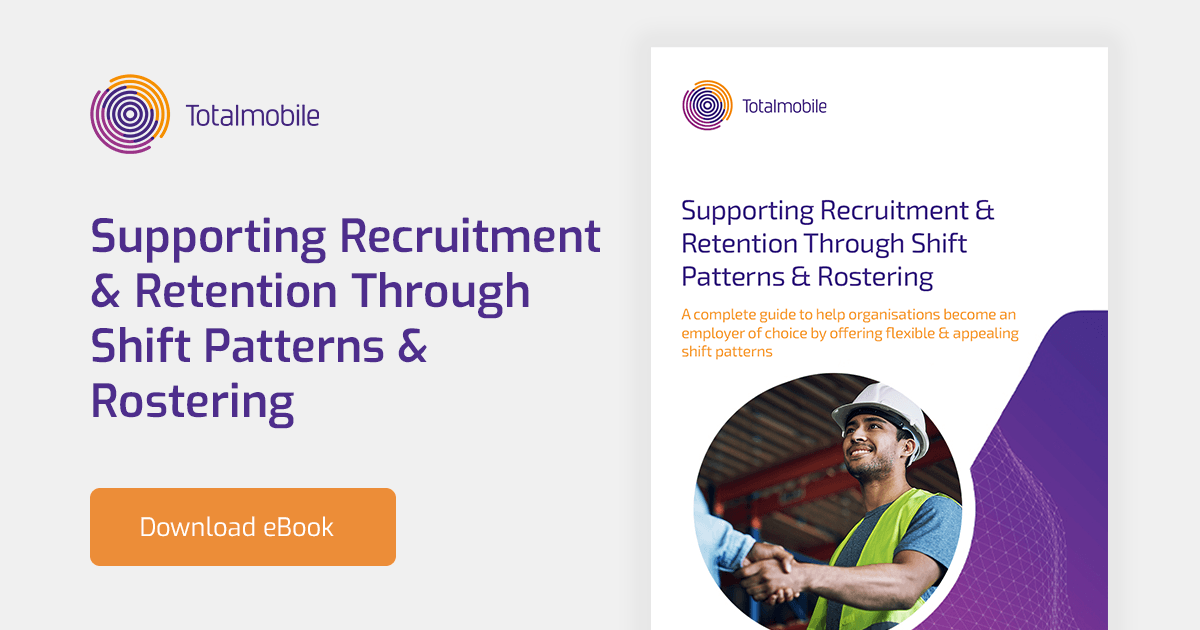Shift Pattern & Rostering Tips to Become an Employer of Choice
In a candidate’s market where vacancies are high, so is the competition to be an employer of choice. For many willingly leaving their current roles, a massive career reinvention is underway. As this is happening, employers are experiencing difficulties attracting and retaining top talent.
Organisations with large mobile workforces are particularly vulnerable. A mass loss of skill at any level within a field service organisation could have a profound cascade effect on the ability to deliver essential services. This is especially pertinent in the health, utility, infrastructure or government administration sectors.
But before we get grey hairs worrying about losing an entire workforce, let’s take a beat. The Great Resignation, as of writing, sees 40% of workers considering quitting. But that doesn’t necessarily mean all workers employed in field service are ready to leave. It may, however, mean that your organisation should consider new strategies and shift rostering to improve retention and career fulfilment. After all, it’s better for business and your employees if they want to work for you and are happy in their role; you are perceived as an employer of choice.

What defines an employer of choice?
The label “employer of choice” relates to desirable perceptions of company culture, leadership style and employee engagement initiatives in the hiring market. In this context, the employee value proposition is vital to becoming a top employer. Employee value is about what employees get in return for their work and time and why they would choose to work for you – work-life balance, role satisfaction, benefits package etc. Glassdoor surveys have found that employees want more than a salary.
- 37% of employees say the company culture is vital
- 35% feel they care about their organisation’s reputation
- 33% said how managers handle interviews
- 25% of employees care about their companies’ missions and values
- 25% said the skills and mentorship of senior leadership
10 Tips for Employer of Choice Status
In the years following 2020, flexible working hours and how we use our time away from work are now critical factors for many. Joblist research found that over 30% of workers would sacrifice part of their salary for a better work-life balance and more favourable shifts, with parents willing to take a 5% pay cut.
Let’s look at ten shift pattern and rostering tips that can help your field service organisation become an employer of choice.
1. Tackle the fundamentals
Avoid morale-sapping work-life balance issues and costly overtime by ensuring your shift patterns reflect changes in demand and capacity. Designing demand-led shift patterns reduce long hours of working and short notice call-ins and creates financial headroom to re-invest in competitive basic salaries.
2. Understand your employees’ needs
Engage your workforce to understand how they feel about shift patterns, whether they fit in with their lives and where they see room for improvement. Involving impartial stakeholders like our rostering experts helps build an accurate picture of sentiment and potential solutions.
3. Prioritise wellbeing
Limit the use of overtime and avoid shift runs that could lead to fatigue and a higher risk of Health & Safety issues. This is key to reducing absence levels that impact productivity and service provision and creating favourable working conditions which improve retention and help attract new talent.
4. Increase the diversity of shift patterns
Broaden your labour pool by creating shift patterns that meet the needs of diverse demographics (e.g. working families, those transitioning into retirement, students etc.). The Shift Pattern Design tools in our Organise software enable you to generate a wide range of tailored options quickly.
5. Use a forward look
Make sure you quickly identify gaps that could lead to capacity issues and redeploy resources in an informed and considered way. Most Time and Attendance systems only tell you what’s happened, so use specialist rostering software like Organise to identify risks and calculate the optimal solution proactively.
6. Be fair
Providing more certainty and fairness around working hours can be crucial to recruitment and retention. Ensure your rostering approach uses an accurate real-time forward view to deliver a fair distribution of shift pattern types, call-in/stand-down notice, overtime assignment and holiday approval.
7. Be accurate
Avoid pay issues that massively erode trust by ensuring the recording of hours and reconciliation with payroll is 100% accurate. Replace paper, spreadsheets and ineffective systems with a cloud-based system that consistently captures and stores all rostering data in real-time.
8. Give employees more control
Empower shift workers to self-roster and organise their own working time using employee self-service apps to book a holiday, shift swap with colleagues or bid for vacant shifts. Providing more autonomy via an employee’s mobile device is a powerful way to improve recruitment and retention.
9. Support employee development
Ensure adequate time is built into rosters to enable training, upskilling or cross-skilling. This is often overlooked and can be a key differentiator when recruiting. This ‘ring fenced’ time must be managed effectively to ensure productivity and customer service levels can also be maintained.
10. Shout about it
Use your appealing, flexible shift patterns and rostering best practice as a critical differentiator in the recruitment market. Over 60% of workers want more control over their working hours, so promoting policies and technology that tangibly support their work-life balance can make all the difference.
Becoming an Employer of Choice
Ready to enhance your shift patterns and rostering? Our rostering experts have created an eBook which provides a complete roadmap toward becoming an employer of choice. Best practices which improve employee satisfaction, avoid capacity issues and ensure you gain a competitive advantage in the market for new talent are outlined in excellent detail.
Ultimately, implementing flexible shift patterns and a postive work-life balance will attract high-quality talent and retain the most experienced and motivated employees.








